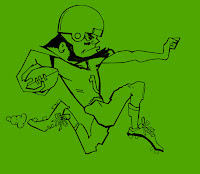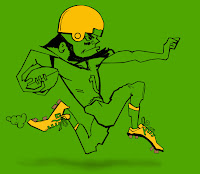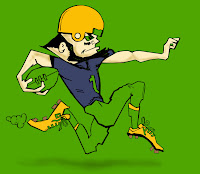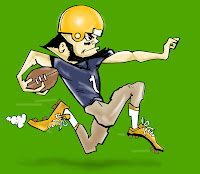Saturday, October 17, 2009
Philosophy of Art Education
I believe that Art Education is mandatory for the complete development of all students. Art Education provides the student with a wealth of knowledge about art and many other subjects. The interdisciplinary possibilities make art education an effective teaching tool. Art students are encouraged to think, and find solutions as they work on different projects. Art is a valuable approach for handling and solving problems. Students learn to constructively criticize work and complete difficult projects. It is an important subject that should never be taken for granted.
Tuesday, October 13, 2009
Monday, October 5, 2009
Silhouette Lesson Plan
Silhouette Lesson Plan
Teacher: Theodore Whitehead
Grade Level: 5
Title: Silhouette Lesson Plan
Brief History and Background:
Impressionist believed the human eye to be a marvelous instrument. Impressionism is a movement in French painting, sometimes called optical realism because of its almost scientific interest in the actual visual experience and effect of light and movement on appearance of objects. The impressionism movement began in 1860 and ended in 1886. The impressionist style has been chosen as the inspiration for this lesson.
Standards:
9.1.5. A. Know and use the elements and principles of Visual Arts:
• color • form/shape • line • space • texture • value
9.1.5. H. Use and maintain materials, equipment
and tools safely at work and performance spaces.
9.2.5 D. Analyze a work of art from its historical and cultural perspective.
National Educational Technology Standards:
1. Creativity and Innovation:
a. Apply existing knowledge to generate new ideas, products, or processes.
5. Digital Citizenship:
a. Advocate and practice safe, legal, and responsible use of information and technology.
6. Technology Operations and Concepts:
a. Understand and use technology systems.
d. Transfer current knowledge to learning of new technologies.
Goal:
Students will create a painting memory series.
Objectives:
* Students will... study the Impressionist
* Students will... Scan photographs
* Students will... paint using the Impressionist style
Resource Materials/Visual Aides:
Computer
Smart Board
Slide Show
Activity Sheet
Supplies/Materials:
Camera / Digital Camera
Paint
Paint brushed
Pencils
Paper
Teacher Preparation:
Gather and place all materials out for lesson
Make sure slide presentation is ready for introduction
Prepare an opening activity
Teaching
Introduction:
Hello class today you will begin a new project. I will provide information about Impressionism. The class will have an opportunity to look at some Impressionist art.
The artist of focus will be Monet.
Directions:
Teacher will gather the students together.
1. Take the box camera home
2. Take photographs of a family outing and or community event.
3. Scan photos and print the photos
4. Select a set of photographs for the project.
5. Make a sketch of the photographs.
6. Paint a representation of each chosen photograph.
Critique/Evaluation/Assessment:
The student will:
Discuss her and his art.
Teacher will ask questions:
What inspires artists?
What is beauty?
Time Budget:
Class 1 & 2: 10 minutes setup before class
10 minutes introduction/discussion/demo
25 minutes Work on art
10 minutes cleanup/critique/discussion
Vocabulary:
Impressionism: a style or movement in painting originating in France in the 1860s, characterized by a concern with depicting the visual impression of the moment, esp. in terms of the shifting effect of light and color.
Movement: a group of people working together to advance their shared political, social, or artistic ideas
Visual experience: Viewing works of art and being able to see the image with little detail.
Safety Concerns: N/A
Bibliography/References:
IMPRESSIONISM
http://www.huntfor.com/arthistory/c19th/impressionism.htm
Teacher: Theodore Whitehead
Grade Level: 5
Title: Silhouette Lesson Plan
Brief History and Background:
Impressionist believed the human eye to be a marvelous instrument. Impressionism is a movement in French painting, sometimes called optical realism because of its almost scientific interest in the actual visual experience and effect of light and movement on appearance of objects. The impressionism movement began in 1860 and ended in 1886. The impressionist style has been chosen as the inspiration for this lesson.
Standards:
9.1.5. A. Know and use the elements and principles of Visual Arts:
• color • form/shape • line • space • texture • value
9.1.5. H. Use and maintain materials, equipment
and tools safely at work and performance spaces.
9.2.5 D. Analyze a work of art from its historical and cultural perspective.
National Educational Technology Standards:
1. Creativity and Innovation:
a. Apply existing knowledge to generate new ideas, products, or processes.
5. Digital Citizenship:
a. Advocate and practice safe, legal, and responsible use of information and technology.
6. Technology Operations and Concepts:
a. Understand and use technology systems.
d. Transfer current knowledge to learning of new technologies.
Goal:
Students will create a painting memory series.
Objectives:
* Students will... study the Impressionist
* Students will... Scan photographs
* Students will... paint using the Impressionist style
Resource Materials/Visual Aides:
Computer
Smart Board
Slide Show
Activity Sheet
Supplies/Materials:
Camera / Digital Camera
Paint
Paint brushed
Pencils
Paper
Teacher Preparation:
Gather and place all materials out for lesson
Make sure slide presentation is ready for introduction
Prepare an opening activity
Teaching
Introduction:
Hello class today you will begin a new project. I will provide information about Impressionism. The class will have an opportunity to look at some Impressionist art.
The artist of focus will be Monet.
Directions:
Teacher will gather the students together.
1. Take the box camera home
2. Take photographs of a family outing and or community event.
3. Scan photos and print the photos
4. Select a set of photographs for the project.
5. Make a sketch of the photographs.
6. Paint a representation of each chosen photograph.
Critique/Evaluation/Assessment:
The student will:
Discuss her and his art.
Teacher will ask questions:
What inspires artists?
What is beauty?
Time Budget:
Class 1 & 2: 10 minutes setup before class
10 minutes introduction/discussion/demo
25 minutes Work on art
10 minutes cleanup/critique/discussion
Vocabulary:
Impressionism: a style or movement in painting originating in France in the 1860s, characterized by a concern with depicting the visual impression of the moment, esp. in terms of the shifting effect of light and color.
Movement: a group of people working together to advance their shared political, social, or artistic ideas
Visual experience: Viewing works of art and being able to see the image with little detail.
Safety Concerns: N/A
Bibliography/References:
IMPRESSIONISM
http://www.huntfor.com/arthistory/c19th/impressionism.htm
CLAUDE MONET
http://www.monetpainting.net/Sunday, October 4, 2009
How to use Photoshop layers to create Art
eLecture
This electure will give a brief history of one of the latest tools for creating art. You will learn about Adobe Photoshop and how to use it to make layered art. In this lecture you will be introduced to the Digital Artist Brian Haberlin. There will be links to his website with video examples of painting in Photoshop. Finally, a step-by-step description showing how to build art with layers is provided.

Adobe Photoshop is a graphics-editing program developed and published by Adobe Systems. Today, Photoshop is leading the market as the best bitmap and image editing software. It is the standard software in the industry for graphic editing.
Thomas Knoll, who attended the University of Michigan created Photoshop. He wrote a program using his Macintosh Plus. The program would create grayscale images on screen. “Display” was the first name for the software. Later Thomas’s brother John Knoll convinced him to make a complete program. Thomas took the time to create his program and called it ImagePro. He took time off from school in order to complete the program. The program was changed to the name Photoshop after a deal was made with the scanner manufacturer Barneyscan. The deal was to provide the software along the scanner. They shipped two hundred copies of the software as a package.
 Brian Haberlin
Brian Haberlin
Copyright © 2001-2009 Haberlin Studios. All rights reserved.
 Brian Haberlin
Brian Haberlin
Copyright © 2001-2009 Haberlin Studios. All rights reserved.
HABERLIN STUDIOS
Brian Haberlin is an artist that uses Photoshop to create the effects seen in his artwork. He began his career in television. He worked for Lorimar and for Warner Brothers studios. He uses new technology as a master painter would use the brush. He has a full portfolio with a variety of comic style art. He has always loved comic book art change careers to work for Image comics’ Top Cow Productions.
Haberlin Studios is an online studio servicing illustration, design, and entertainment. Brian’s studios have worked with all of the top comic book companies. He has worked with the comics for Spawn, X-Men, Daredevil, Spider Man and many others. His studio is remarkable, focusing on comic book art. Brain developed the Witchblade for Television and Hellcop for live action. Brian Haberlin is also the co-creator of the comic book Aria.
To learn more about Brian Haberlin, visit his web site at HABERLIN STUDIOS
Examples:
Begin Start Finish
Photo Real Start Finish
Note to the parents:
This activity has been chosen for the 7th and 8th grade student. The content has been chosen to display the artist’s skills. The selection is not intended to offend but to educate the students who use the electure as a learning tool.
Supplies:
Computer
Adobe Photoshop
Scanner
Scanner Software
Pencil
Pen
Directions:
Art by Theodore Whitehead ©2009
For Educational Purposes only
Make a drawing in your sketchbook or a complete drawing you would like to scan.
Make sure the image has completed outlines. This will be helpful later when you need to fill areas in Photoshop.
Lay image / picture on the scanner
Scan image into Photoshop or scan using the scanning software on your computer.
Scan file as a tiff file format.
Check resolution and size of the image scanned. Recommend 300 dpi resolution
Open the file in Photoshop.
After choosing the resolution, make about ten layers as a starter.
Place the scanned image on the bottom layer.
Now cleanup the line work.
Use the eraser tool to delete any unwanted lines.
Double click on each layer in order to apply a name.
Use the paint tool in order to fill in areas of the image.
Use a layer for each different color.




Continue to fill in color until it is completed
Clean up all edges and add texture
This electure will give a brief history of one of the latest tools for creating art. You will learn about Adobe Photoshop and how to use it to make layered art. In this lecture you will be introduced to the Digital Artist Brian Haberlin. There will be links to his website with video examples of painting in Photoshop. Finally, a step-by-step description showing how to build art with layers is provided.
The history of a new art tool

Adobe Photoshop is a graphics-editing program developed and published by Adobe Systems. Today, Photoshop is leading the market as the best bitmap and image editing software. It is the standard software in the industry for graphic editing.
Thomas Knoll, who attended the University of Michigan created Photoshop. He wrote a program using his Macintosh Plus. The program would create grayscale images on screen. “Display” was the first name for the software. Later Thomas’s brother John Knoll convinced him to make a complete program. Thomas took the time to create his program and called it ImagePro. He took time off from school in order to complete the program. The program was changed to the name Photoshop after a deal was made with the scanner manufacturer Barneyscan. The deal was to provide the software along the scanner. They shipped two hundred copies of the software as a package.
Brian Haberlin
 Brian Haberlin
Brian HaberlinCopyright © 2001-2009 Haberlin Studios. All rights reserved.
 Brian Haberlin
Brian HaberlinCopyright © 2001-2009 Haberlin Studios. All rights reserved.
HABERLIN STUDIOS
Brian Haberlin is an artist that uses Photoshop to create the effects seen in his artwork. He began his career in television. He worked for Lorimar and for Warner Brothers studios. He uses new technology as a master painter would use the brush. He has a full portfolio with a variety of comic style art. He has always loved comic book art change careers to work for Image comics’ Top Cow Productions.
Haberlin Studios is an online studio servicing illustration, design, and entertainment. Brian’s studios have worked with all of the top comic book companies. He has worked with the comics for Spawn, X-Men, Daredevil, Spider Man and many others. His studio is remarkable, focusing on comic book art. Brain developed the Witchblade for Television and Hellcop for live action. Brian Haberlin is also the co-creator of the comic book Aria.
To learn more about Brian Haberlin, visit his web site at HABERLIN STUDIOS
Examples:
Begin Start Finish
Photo Real Start Finish
Note to the parents:
This activity has been chosen for the 7th and 8th grade student. The content has been chosen to display the artist’s skills. The selection is not intended to offend but to educate the students who use the electure as a learning tool.
Supplies:
Computer
Adobe Photoshop
Scanner
Scanner Software
Pencil
Pen
Directions:
Art by Theodore Whitehead ©2009
For Educational Purposes only
Make a drawing in your sketchbook or a complete drawing you would like to scan.
Make sure the image has completed outlines. This will be helpful later when you need to fill areas in Photoshop.
Lay image / picture on the scanner
Scan image into Photoshop or scan using the scanning software on your computer.
Scan file as a tiff file format.
Check resolution and size of the image scanned. Recommend 300 dpi resolution
Open the file in Photoshop.
After choosing the resolution, make about ten layers as a starter.
Place the scanned image on the bottom layer.
Now cleanup the line work.
Use the eraser tool to delete any unwanted lines.
Double click on each layer in order to apply a name.
Use the paint tool in order to fill in areas of the image.
Use a layer for each different color.




Art by Theodore Whitehead ©2009
For Educational Purposes only
For Educational Purposes only
Continue to fill in color until it is completed
Clean up all edges and add texture
Saturday, October 3, 2009
The Day The Earth Stood at The Movies
WebQuest
The Day The Earth Stood at The Movies
A WebQuest for 8th Grade (Art Education)
Introduction

Directed by Robert Wise. With Michael Rennie, Patricia Neal, Hugh Marlowe.
The robot Gort, able to destroy tanks with his deadly rays,
in The Day the Earth Stood Still (1951).
Congratulations!! You and your crew have been selected for a special mission.
You will be taking a journey into the world of special effects.
For centuries magicians have fooled people with the optical illusion. In the 1700s, magicians used many techniques that have influenced the field of special effects that are seen in movies today. The viewer was led to believe that a person in the form of a ghost was real. The magician used a box to project a light, which formed an image of a person. The image was a ghost. The viewer was tricked to believe the ghost was real. Today in the 21st century movies are saturated with the art of special effects. Millions of viewers watch movies that fool the mind. Do the movies really fool the mind?
The Task
The goal of this WebQuest is to review movies with special effects.
You and your crew have been chosen for this very special mission. Your mission is to preview special effects in movies. Your crew will travel into the world of cinematography. You will travel with in a vessel know as the Internet One. The crew captain will assign the crew members with a responsible duty. All crew members will report gathered data to the captain. The captain’s log will be the combined so that all data can be placed in to the crews main journal.
The crew will watch the latest movie previews on the Internet. The purpose is to gather data about movies the team would or would not recommend. The crewmembers will also read the story description for each movie. The crewmembers will decide if the story description has peeked an interest in the movie or not.
The Process
The first thing that the captain and the crewmembers need to do is decide which movies the group will review. The team should review at least 12 movies with special effects. The crew should also consider current movies playing the theaters. All crewmembers will watch the same previews. Selected crewmembers will read the story descriptions for three movies. The crewmembers assigned to review the movies will be called scribes. The story description will then be discussed among the crew. The scribes will write a report about the movie story description. All movie descriptions will be compiled into the captain’s log. The crew will gather and determine which movies it will recommend for viewing. The captain will present his or her log for the final presentation.
There are various roles for the crew. Below is a list of crew roles, which need to be selected.
The Captain
Every crew needs a leader. The crew captain is the glue that holds the team together. The captain is a motivator for the crew. He or she will show excitement and enthusiasm for the project. The captain will check to see that all crewmembers are on task.
The Navigator
The crew needs to know where to look for information. The navigator will know how to find information on the Internet. Crewmembers will contact the navigator to get help in order to find locations on the Internet.
The Researcher
All crewmembers on this team will be researchers. Each crewmember will be given an instruction manual that describes how to find all locations for the movie previews.
The Scribe
All crewmembers on this team will be scribes. The scribe will keep a written record of each movie previewed. The written record will include the title of the movie, the producer, the director, and two members of the cast. The scribe will also give the date that the move will appear in theaters.
Once all roles have been distributed, each crewmember should visit the web sites and begin to compile all of the information for which he or she is responsible.
After all information has been collected you must write your review of the movie and decide if it is worth seeing. Finally the crew will meet as a group and discuss which movies the group will recommend for viewing. All reviews will become a part of the captain’s log.
The following links will be extremely helpful to you when your crew researches its movie selections.
apple.com iTunes Movie Trailers
The Internet Movie Database
Yahoo! Movies
Evaluation
Crewmembers will be graded individually based on the following:
-Fulfillment of his/her job
-Quality of material included in the scribes journals
-Content, organization, and mechanics of the persuasive writing
-Creativity -neatness exhibited in the final piece
Each crew will also receive a grade as a whole and it will be based on the following:
-Overall appearance of the final product
-The collaborative effort exhibited to complete the captain’s log
-Met the requirements for the project criteria
Conclusion
The Internet can be a valuable resource to all people, particularly when they need to get information quickly and successfully. Traveling on the Internet can be just as enjoyable for cyber surfers as it is for movie enthusiasts. Not all people take the time to read the movie story description, so the Internet offers an opportunity that they may acquire information about movies of interest.
By completing this WebQuest, you have cooperated with your peers to gain knowledge about your selected destination and technological skills to create electronic products, and to improve your writing skills.
Credits
Special Effects
http://utminers.utep.edu/lacarrera/history.htm
The Day The Earth Stood Still 1951
http://www.youtube.com/watch?v=OfpSXI8_UpY
The Day The Earth Stood Still 2008
http://www.youtube.com/watch?v=A_bNDv0-ZrU&feature=related
apple.com iTunes Movie Trailers
http://www.apple.com/trailers/
The Internet Movie Database
http://www.imdb.com/
http://www.imdb.com/boxoffice/alltimegross?region=world-wide
Yahoo! Movies
http://movies.yahoo.com/
DEFINITION
http://www.merriam-webster.com/dictionary/DEFINITION
The Day The Earth Stood at The Movies
A WebQuest for 8th Grade (Art Education)
Introduction
Directed by Robert Wise. With Michael Rennie, Patricia Neal, Hugh Marlowe.
The robot Gort, able to destroy tanks with his deadly rays,
in The Day the Earth Stood Still (1951).
Congratulations!! You and your crew have been selected for a special mission.
You will be taking a journey into the world of special effects.
For centuries magicians have fooled people with the optical illusion. In the 1700s, magicians used many techniques that have influenced the field of special effects that are seen in movies today. The viewer was led to believe that a person in the form of a ghost was real. The magician used a box to project a light, which formed an image of a person. The image was a ghost. The viewer was tricked to believe the ghost was real. Today in the 21st century movies are saturated with the art of special effects. Millions of viewers watch movies that fool the mind. Do the movies really fool the mind?
The Task
The goal of this WebQuest is to review movies with special effects.
You and your crew have been chosen for this very special mission. Your mission is to preview special effects in movies. Your crew will travel into the world of cinematography. You will travel with in a vessel know as the Internet One. The crew captain will assign the crew members with a responsible duty. All crew members will report gathered data to the captain. The captain’s log will be the combined so that all data can be placed in to the crews main journal.
The crew will watch the latest movie previews on the Internet. The purpose is to gather data about movies the team would or would not recommend. The crewmembers will also read the story description for each movie. The crewmembers will decide if the story description has peeked an interest in the movie or not.
The Process
The first thing that the captain and the crewmembers need to do is decide which movies the group will review. The team should review at least 12 movies with special effects. The crew should also consider current movies playing the theaters. All crewmembers will watch the same previews. Selected crewmembers will read the story descriptions for three movies. The crewmembers assigned to review the movies will be called scribes. The story description will then be discussed among the crew. The scribes will write a report about the movie story description. All movie descriptions will be compiled into the captain’s log. The crew will gather and determine which movies it will recommend for viewing. The captain will present his or her log for the final presentation.
There are various roles for the crew. Below is a list of crew roles, which need to be selected.
The Captain
Every crew needs a leader. The crew captain is the glue that holds the team together. The captain is a motivator for the crew. He or she will show excitement and enthusiasm for the project. The captain will check to see that all crewmembers are on task.
The Navigator
The crew needs to know where to look for information. The navigator will know how to find information on the Internet. Crewmembers will contact the navigator to get help in order to find locations on the Internet.
The Researcher
All crewmembers on this team will be researchers. Each crewmember will be given an instruction manual that describes how to find all locations for the movie previews.
The Scribe
All crewmembers on this team will be scribes. The scribe will keep a written record of each movie previewed. The written record will include the title of the movie, the producer, the director, and two members of the cast. The scribe will also give the date that the move will appear in theaters.
Once all roles have been distributed, each crewmember should visit the web sites and begin to compile all of the information for which he or she is responsible.
After all information has been collected you must write your review of the movie and decide if it is worth seeing. Finally the crew will meet as a group and discuss which movies the group will recommend for viewing. All reviews will become a part of the captain’s log.
The following links will be extremely helpful to you when your crew researches its movie selections.
apple.com iTunes Movie Trailers
The Internet Movie Database
Yahoo! Movies
Evaluation
Crewmembers will be graded individually based on the following:
-Fulfillment of his/her job
-Quality of material included in the scribes journals
-Content, organization, and mechanics of the persuasive writing
-Creativity -neatness exhibited in the final piece
Each crew will also receive a grade as a whole and it will be based on the following:
-Overall appearance of the final product
-The collaborative effort exhibited to complete the captain’s log
-Met the requirements for the project criteria
Conclusion
The Internet can be a valuable resource to all people, particularly when they need to get information quickly and successfully. Traveling on the Internet can be just as enjoyable for cyber surfers as it is for movie enthusiasts. Not all people take the time to read the movie story description, so the Internet offers an opportunity that they may acquire information about movies of interest.
By completing this WebQuest, you have cooperated with your peers to gain knowledge about your selected destination and technological skills to create electronic products, and to improve your writing skills.
Credits
Special Effects
http://utminers.utep.edu/lacarrera/history.htm
The Day The Earth Stood Still 1951
http://www.youtube.com/watch?v=OfpSXI8_UpY
The Day The Earth Stood Still 2008
http://www.youtube.com/watch?v=A_bNDv0-ZrU&feature=related
apple.com iTunes Movie Trailers
http://www.apple.com/trailers/
The Internet Movie Database
http://www.imdb.com/
http://www.imdb.com/boxoffice/alltimegross?region=world-wide
Yahoo! Movies
http://movies.yahoo.com/
DEFINITION
http://www.merriam-webster.com/dictionary/DEFINITION
Subscribe to:
Comments (Atom)




